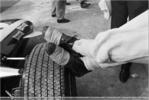Message Board Disclaimer and Terms of Use
This is a public forum. Messages posted here can be viewed by the public. The Early 911S Registry is not responsible for messages posted in its online forums, and any message will express the views of the author and not the Early 911S Registry. Use of online forums shall constitute the agreement of the user not to post anything of religious or political content, false and defamatory, inaccurate, abusive, vulgar, hateful, harassing, obscene, profane, sexually oriented, threatening, invasive of a person's privacy, or otherwise to violate the law and the further agreement of the user to be solely responsible for and hold the Early 911S Registry harmless in the event of any claim based on their message. Any viewer who finds a message objectionable should contact us immediately by email. The Early 911S Registry has the ability to remove objectionable messages and we will make every effort to do so, within a reasonable time frame, if we determine that removal is necessary.



 Reply With Quote
Reply With Quote


 . Other thin panels were less accessible spots, even of owner is willing to prod around.
. Other thin panels were less accessible spots, even of owner is willing to prod around. . Agree there will be some with mix during transition around 1036 that wil not be known. But later on almost certainly no light panels left so why call ALL these M471 lightweight. Lightweight in early RS goes beyond the gauge of a dozen panels, regular paint not dimpled paint on the early cars eg rear chassis rails, plastic horn push, front crossmember and so forth. All M472 by implication if not lightweight are heavyweight... Really? Heavier in weight due to customer M472 conversion order trim granted but still these are the lightweight bodyshell the factory homologated because each chassis was demonstrably proven to be a lightweight at Stuttgart scales and recorded so by FIA. Subsequent chassis not ( usually) so. In fact most (if not all) of those 500 later chassis known to be not built lightweight bodyshell due to e.g. metal gauge, dimpled paint in those areas, different rear bumper, series rear quarter window, change to cross member and so forth.
. Agree there will be some with mix during transition around 1036 that wil not be known. But later on almost certainly no light panels left so why call ALL these M471 lightweight. Lightweight in early RS goes beyond the gauge of a dozen panels, regular paint not dimpled paint on the early cars eg rear chassis rails, plastic horn push, front crossmember and so forth. All M472 by implication if not lightweight are heavyweight... Really? Heavier in weight due to customer M472 conversion order trim granted but still these are the lightweight bodyshell the factory homologated because each chassis was demonstrably proven to be a lightweight at Stuttgart scales and recorded so by FIA. Subsequent chassis not ( usually) so. In fact most (if not all) of those 500 later chassis known to be not built lightweight bodyshell due to e.g. metal gauge, dimpled paint in those areas, different rear bumper, series rear quarter window, change to cross member and so forth.